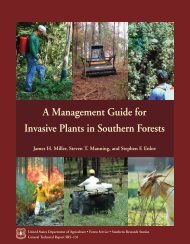Introduction - Stored Grain Pest Management Pest Management for ...
Introduction - Stored Grain Pest Management Pest Management for ...
Introduction - Stored Grain Pest Management Pest Management for ...
Create successful ePaper yourself
Turn your PDF publications into a flip-book with our unique Google optimized e-Paper software.
Temperatures below 60°F prevent insect activities, while higher temperatures allow <strong>for</strong>increased insect growth and breeding. Many storage structures are equipped withtemperature sensors that provide the temperature of the grain through the grain mass.The sensors are place on permanent cables that are sus-pended from the roof of thestorage bin. Three are midway between the center and the wall, and one is very near thecenter (Figure 1.16).In<strong>for</strong>mation is transmitted <strong>for</strong> each thermocouple to a reading device that helps grainmanagers record temperature over time. More than a five-degree rise (>5 0 F) recorded byone of the thermocouples over a two-week period indicates a pest or moisture problemexists in that location. Monitoring also detects changes in grain temperature duringaeration or seasonal temperature fluctuations. Temperature of the stored grain in binswithout temperature monitoring devices can be monitored by a thermometer mounted ona probe and inserted into the grain mass, or simply by inserting one’s arm into the toplayer of the grain mass.Frequent grain sampling from several locations throughout the storage structure providesgrain managers with the status of insects and grain quality. Initial sampling should bedone at least weekly until the history of the grain has been clarified. In many warmerlocations, samples are collected from standing grain using either a deep bin cup or a graintrier (Figure 1.17).
















